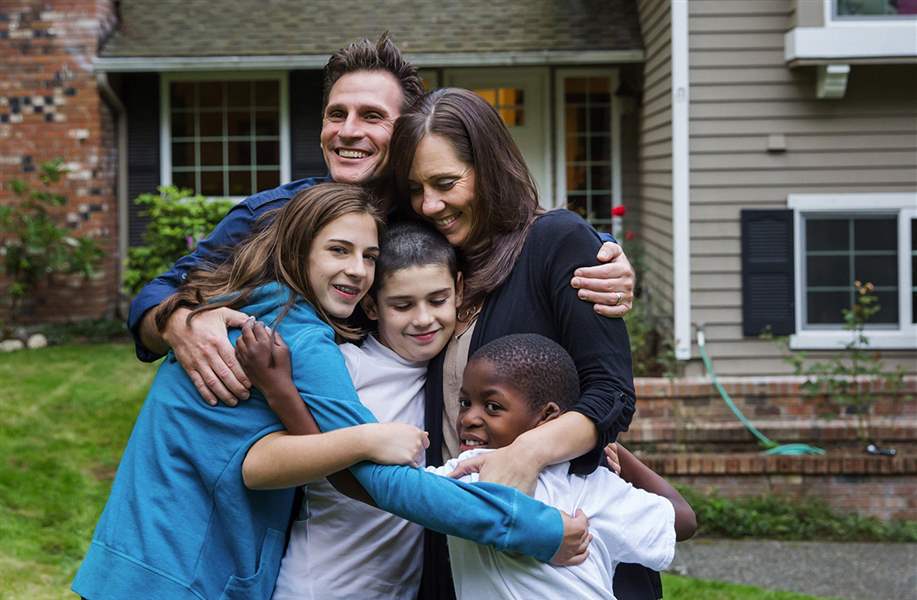
Getting schooled: Shaken by HIV lessons, a mom shakes up what’s taught
10/7/2013
Michael and Jodie Howerton are shown with kids Alex, 13, left, Caleb, 11, and Mduduzi, 8, who is HIV-positive.
SEATTLE TIMES

SEATTLE — When her daughter was going into the fifth grade two years ago, Jodie Howerton reviewed the HIV/AIDS educational materials that would be used in her child’s class — and was appalled by what she saw.
The opening clip of a video, circa early 1990s, featured this headline: “Thousands die of AIDS.”
In it, the human immunodeficiency virus (HIV) was dressed as a growling, red monster and there was a cameo appearance by the Grim Reaper.
The outdated images and statistics about AIDS (acquired immunodeficiency syndrome) and the virus that causes it, were particularly troublesome to the Woodinville, Wash., mother of three, who had adopted a son born with HIV and who worried the video would perpetuate existing stereotypes.
Treatment for HIV/AIDS has advanced light-years in the three decades since the first U.S. cases were reported. Now, with proper medications, those infected can live long and relatively healthy lives.
“There was not a word about being born with the virus,” Howerton said of the video, which the district has since stopped using. “It was a scary, fear-based video that would teach people how to be afraid of my son.”
Working with the Northshore School District where her daughter was enrolled at Cottage Lake Elementary School, Howerton scoured the Internet for current and age-appropriate videos to replace the district’s last-century set.
Finding none, the communications specialist set about to make some.
As part of a campaign she’s calling Redefine Positive, Howerton sat down a year ago with representatives from the state Office of the Superintendent of Public Instruction (OSPI), Seattle Children’s Hospital Foundation, Public Health — Seattle & King County, Northshore schools and other parents and advocates to discuss a series of documentary-style educational videos that could be used not just at her children’s school, but in elementary, middle and high schools throughout the state.

Michael and Jodie Howerton are shown with kids Alex, 13, left, Caleb, 11, and Mduduzi, 8, who is HIV-positive.
Production work on the first two videos is to begin in November.
“Not many kids are being born in the U.S. with this disease, but a number of kids who are HIV-positive are being adopted,” she said. “These kids, like my son, are going to sit down in classrooms where inaccurate, outdated information is being presented.”
Howerton says she worries that without the latest and most accurate information, children like her son would be discriminated against and ostracized.
“It’s time to educate all our kids in a way that reduces the devastating stigma still associated with HIV.”
Washington is one of 33 states along with the District of Columbia that mandate schools teach children about HIV/AIDS.
The state Legislature passed the law at the height of the AIDS epidemic in 1988, requiring that education on the “life-threatening dangers of the disease, its spread, and prevention begin in the fifth grade.”
Parents are allowed to review the teaching materials.
Sandra Tracy, health and nursing supervisor for the Northshore schools, said the district was aware that the fifth-grade video wasn’t perfect and for years had been searching for a more recent one — without luck.
“The videos are supplementary; they’re not required,” she said. “Many teachers like to use them as a way to start the dialogue.”
After Howerton raised concerns, the district replaced the fifth-grade video with the one used for sixth-graders — a perhaps less engaging one that features adults talking to children about AIDS.
Twenty years ago, Tracy said, more parents would come to the school to view the HIV/AIDS material because the disease was still new and parents were concerned about what schools would be telling their children.
These days, not so much.